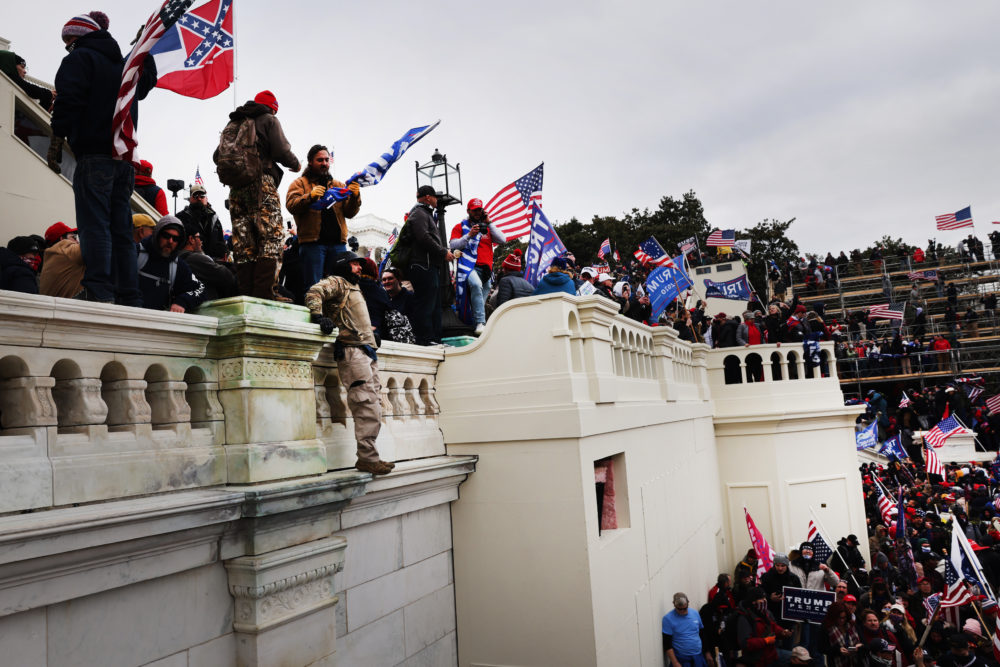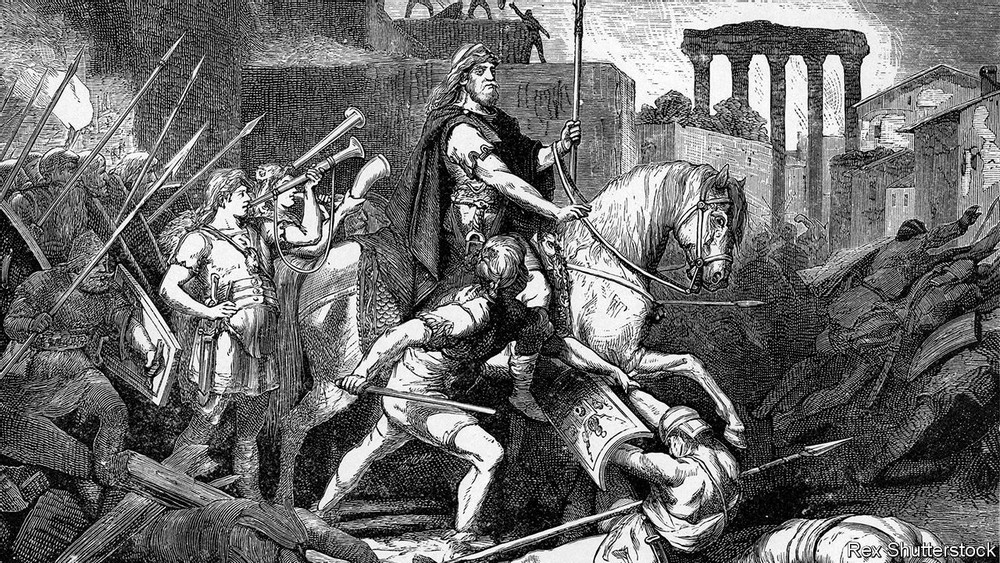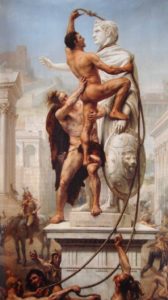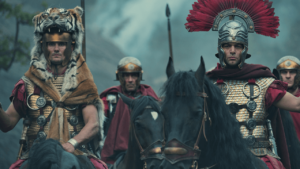From the Margins
The Barbarians at the Gate: The Sack of Rome and the Attack on the U.S. Capitol
The problems with imagining who the barbarians are in the U.S. today

Rioters storming past the gates of the U.S. Capitol Building on 1/6/2021. (Photo: Spencer Platt)
Beware. The barbarians are at the gate! For as long as the U.S. republic has existed, and ever since Edward Gibbon began publishing his six-volume The History of the Decline and Fall of the Roman Empire, ancient Rome has served as an analogy for our nation’s greatness and, perhaps, its eventual demise. For some, today’s barbarian threat stems from an influx of immigrants, cultural shifts away from conservative Christian values, and the election of progressive Democratic politicians such as Alexandria Ocasio-Cortez and Raphael Warnock. For others, the existential threat to our polity arises from Donald Trump, his Republican cronies who disregard democratic norms, and insurrectionists who want to impose their agenda by any means necessary.
The attack on the U.S. Capitol on January 6, 2021, has become the symbolic equivalent to the sack of Rome by Alaric and the Goths on August 24, 410 CE. Ironically, the shocking footage and images of the breach of the Capitol in Washington, D.C., have displayed the brazen acts of Trump-supporting hordes who believe themselves to be saving America from radical Marxists. They see themselves as patriots at the gate. In one interpretation or another, barbarians are driving this nation to the brink. But the problem with many of these analogies is that the so-called barbarians who sacked Rome in 410 are emptied of historical concreteness and reduced to an archetype. We’re so used to hearing the parable of the barbarians at the gate that most of us know little or nothing about who these barbarians were and about what transpired during this period of the Roman Empire. What we may know is likely heavily skewed. Having a clearer understanding of this period can help us to understand the lies told about the Goths and the problem with imagining barbarian invasions today.
Historian Douglas Boin’s Alaric the Goth: An Outsider’s History of the Fall of Rome provides a much-needed corrective. He makes deft use of scarce historical material on Alaric to reconstruct a glimpse of the man. The heart of the book is a wider cultural history of late 4th/early 5th century Rome that highlights the empire’s tensions with immigration and the political impact of fanatical Christians. Boin also recontextualizes the sack of Rome in 410, including the details about what happened in the three days of the breach. When Alaric and the Goths pillaged Rome, it sent shockwaves across the empire. Augustine claimed that people “in the farthest parts of the earth” were setting aside “days of public grief and mourning.” Jerome wrote, “The city that once captured the hearts and minds of the world has been captured!” However, the Goths’ occupation of Rome, which was accompanied by fires and the deaths of notable figures like Marcella of the Aventine Hill, appears to have been rather mild by the standards of the time. Boin suggests that Alaric’s attack on Rome was in retaliation for personally being denied citizenship and for the empire’s injustices against Goths.
Rome had sixteen main gates around its walls that were rigorously secured and patrolled by soldiers. These hadn’t been breached since the Gauls’ sack of Rome around 390 BCE. To pull off Alaric’s occupation required insider knowledge, which he possessed as a former Roman soldier, and probably some help from within the city. According to one account, Alaric spared any Romans who sought sanctuary in churches and commanded his men “that as far as possible, they must refrain from shedding blood in their hunger for booty.” By comparison, the destruction to the city caused by Nero’s fires was far worse. After a Gothic soldier encountered an elderly woman protecting the gold and silver vessels from St. Peter’s Basilica, Alaric “immediately ordered that all the vessels should be taken back, just as they had been found, to the basilica of the Apostle [Peter].” Both Romans and Goths “joined together in singing openly a hymn of praise to God.” Even Augustine, in City of God, wrote about “those very Romans, who were spared by the barbarians through their respect for Christ…”
The Romans borrowed the epithet barbarian from the Greeks to describe foreigners like the Goths, many of whom had lived within Rome’s borders and converted to Arian Christianity by the time Alaric sacked the city. Renaissance accounts of the Goths inaugurating the “dark ages” bequeathed to us an imagination of Goths as savages hell-bent on destroying Roman culture and institutions. Boin points out that archeologists in the early 20th century like Rodolfo Lanciani continued to repeat smears against the Goths, interpreting “every broken pot in the city” as “proof of the crimes pinned on Goths.” But Goths’ relationship with Rome was more complicated, just like their relationship with Christianity, which embraced a different interpretation of Christ than that of the Nicene faith. At the Council of Nicaea convened by Emperor Constantine in 325 CE, Arius of Alexandria and his followers had proposed that Jesus and God were of a similar (homoios) substance. Those who opposed Arian Christians and argued that Jesus and God were of the same (homos) substance would eventually claim the mantle of “Nicene” and “orthodox” Christianity.
In terms of historical material, little is known about Alaric, who became the de facto leader of the Goths. But what Boin establishes about Alaric and his era significantly reframes the stereotypical narrative. As he puts it, “Alaric came of age at a time when high-placed politicians wanted Gothic boys like him dead, when few ordinary Romans cared to acknowledge the cruelties that had occurred at their own borders, and when even the casual comments of educated Romans dehumanized his people.” When Alaric breached Rome’s walls, he was no stranger to the empire. Born along the empire’s northern border with the Danube River, Alaric enlisted as a soldier for the Romans as a young man during the thawing of Gothic-Roman relations in the 390s; this provided great benefits, such as a stipend otherwise not available to him because he lacked Roman citizenship. Alaric was climbing the ranks of the Roman military when his position in Illyricum was suddenly terminated. His decision to invade Rome was preceded by failed attempts at negotiations with Rome’s ruling elites. The Goths demanded better treatment and land, and Alaric allegedly proposed that they wanted to “live with the Romans [so] that men might believe them both to be of one family or people.”

A depiction of Alaric the Goth
Immigrants and refugees had always been central to Rome’s history and its identity. Plutarch said that the city was founded as an asylum. Virgil described the hero of The Aeneid as a wanderer. In 212 CE, the Emperor Caracalla passed the significant Antonine Declaration, which granted citizenship to every free-born resident of a Roman province. Rome’s senate looked increasingly “multicultural” by our standards. Rome’s emperors, like Septimius Severus, could come from Roman territory in Africa, or, like Trajan and Hadrian, from the province of Spain. But for all its apparent inclusivity, the Roman Empire still harbored deep xenophobia. True belonging didn’t depend on legal citizenship but on Romanitas or how one dressed, spoke, and behaved. Ovid said of those at the edge of Rome’s borders, “They have more of cruel savagery than wolves.” According to Claudian, a Roman contemporary of Alaric, “Everyone insults the immigrant.”
In 235, Maximinus Thrax was the first foreigner with a “barbarian” background to become Roman emperor after being made a citizen through Caracalla’s law. But for traditionalists, Maximinus’ background was a strike against him. A group of senators stubbornly opposed him and called him a “Cyclops,” using Homeric language to depict him as a monster. His reign was short-lived. In 238, Maximinus was assassinated, and senators picked a replacement named Gordian who, according to Boin, signified an abrupt return to Rome’s “traditional ways.”
By the time Alaric sacked Rome in 410, around 30,000 Goths lived within the city and every Roman home was said to have at least one or two Gothic slaves. The Roman Empire had extended citizenship on a large scale at least three times in its history, culminating with Caracalla’s law. But the extension of citizenship had largely stalled in Alaric’s day and most Goths lacked citizenship and full legal protections. Around 377, Emperor Valens created a policy of forced relocation of young Gothic men in order to instill in them Roman values and prevent rebellion. In 408, after the execution of a Roman general who had roots in another barbarian group known as the Vandals, Romans indiscriminately attacked Gothic men, women, and children in the city. Thousands of Goths responded by pouring into the streets in protest.

An 1890 painting titled “Sack of Rome” by Joseph-Noël Sylvestre
Alaric’s sack didn’t emerge from a vacuum but from a cultural tinderbox related to Gothic and Roman relations. Goths who enlisted to fight for Rome didn’t always meet a better fate — as exemplified by Alaric’s situation and by Emperor Theodosius’ cold calculation to sacrifice thousands of Gothic soldiers on the front lines of the battlefield. And Christian attitudes on the Goths didn’t necessarily differ from that of their non-Christian counterparts. The Christian bishop Synesius maintained that the Gothic people were an animalistic race, and that the government should “admit no fellowship with these foreigners” but, rather, would do better to “disown their participation” in public life.
Christians of the Nicene camp were politically ascendant in this era. Many people attribute this to Emperor Constantine’s conversion and his legalization of Christianity in 313. But no emperor did more for Christians politically than Theodosius who made Nicene Christianity the state religion of the Roman Empire in 380, and whom Christians called “The Great.” Boin writes of Theodosius, “he used every tool available to an emperor — the laws, imperial decrees, a soft touch, veiled threats, and actual physical force — to implement his vision for a single-party Christian state.” Bishops like Ambrose of Milan preached that angels were fighting demons for control of the empire and that Theodosius deserved Christians’ unqualified support. Boin adds, “In 388, after Christians burned a [Jewish] synagogue at Callinicum, in Syria, no one was held accountable; Theodosius refused to punish the guilty faction of Christians because they counted among his most loyal supporters.” Fanatical Christians were emboldened under Theodosius’ reign. In 393, to their joy, Theodosius went as far as to criminalize nearly every aspect of pagan worship. Rome passed nearly twenty edicts against Paganism by the year 400.
The “Make Christianity Great” agenda of Theodosius and his Christian supporters was unsuccessfully opposed by several pagans and moderate Christians. Symmachus, a pagan senator, defended the freedom of religious pluralism, writing: “The truth of why things happen is hidden at the end of a multiplicity of roads and pathways.” Some Christians considered this approach dangerous. In Against Symmachus, the Christian poet Prudentius responded, “The windings of the labyrinth offer little but doubtful corners and the promise of more uncertainty.” Boin says, “Other Christians composed misleading prophecies, modeled after a collection of widely regarded pagan writings called The Sibylline Oracles, and shared them with other Christians to stoke anxiety about another coming age of persecution.” Christians like Lactantius, the tutor to Emperor Constantine’s children, described Theodosius’ supporters and the more fanatical Christians as Deliri or “crazies.”
Christian senators who tried to compromise with pagans were branded as “apostates” by other Christians. Theodosius’ Christian-supremacist rule inspired segments of the population to back usurpers such as Flavius Eugenius, a Christian who supported the right to open pagan worship. According to one account, members of the church told Eugenius that he was not a “real Christian.” Eugenius eventually faced off Theodosius in a civil war. Ultimately, Theodosius, while using Gothic troops on the frontlines, defeated Eugenius in 394. He impaled Eugenius’ head on a stick and displayed it around Italy. While orthodox Christians later mythologized Theodosius, highlighting stories such as his alleged public repentance before Ambrose for his responsibility in a massacre at Thessaloniki, Theodosius’ reign helped elevate the perspectives of Nicene Christian writers while erasing those of pagans and rival Christians. As the classicist Mary Beard puts it in SPQR: A History of Ancient Rome, “The Christian texts of the third, fourth and fifth centuries CE are some of the most extreme examples ever of the rewriting of history to fit the agenda of the winners.”
When Alaric and the Goths sacked Rome in August 410, Christians interpreted it in a number of ways. Within a month, some Christians compared it to the destruction of Sodom and Gomorrah and saw an apocalyptic line in the book of Ezekiel about Gog as a warning about “the Goths.” In City of God, Augustine saw the sack as a disaster and used it as an opportunity to theologically bury Rome’s pagan gods — which according to him were really demons — once and for all. Although he acknowledges Alaric’s merciful behavior, Augustine credits God for bridling the “fierce and bloody minds” of the Arian Christian barbarians. Like eavesdropping on one side of a debate, City of God shows us Augustine setting up his arguments against pagan opponents who apparently blamed Christianity for the breach of Rome’s walls. Other Christians thought Alaric’s sack of Rome wasn’t a disaster or a big deal. In Seven Books of History Against the Pagans, Orosius, a Christian historian from Spain and a personal pupil of Augustine, parted ways with the gloomy outlook of Augustine and Jerome. Orosius wrote more sympathetically about the Goths, believed that Nero’s fires and the Gauls’ sack were worse than Alaric’s occupation, and shied away from more apocalyptic or theologically somber pronouncements.
***
For more than a thousand years, we’ve inherited debates about the fall of the Roman Empire that lay all the blame at the feet of Christianity, or Paganism, or barbarians, or immigrants. Edward Gibbon, a masterful stylist, mostly blamed Christianity and barbarians in an account suggesting that empires rise and fall like the sun, due to “the natural and inevitable effect of immoderate greatness.” Yet most historians today would avoid characterizing Rome’s collapse — or transition, transformation, etc. — as resulting from only a couple of factors. In fact, it’s become increasingly clear that other realities, like climate and disease, were also pivotal.
In The Fate of Rome: Climate, Disease, and the End of an Empire, Kyle Harper writes, “The fate of Rome was played out by emperors and barbarians, senators and generals, soldiers and slaves. But it was equally decided by bacteria and viruses, volcanoes and solar cycles.” Building on fascinating research that combines a scientific and humanistic approach, Harper argues that the Roman Empire emerged during a phase of warm, wet, and stable climate across much of the Mediterranean that he calls the “Roman Climate Optimum.” The “Little Ice Age” that resulted from volcanic activity in the 530s and 540s CE demonstrates how much climate could impact the empire’s agriculture and economic growth. “Even more consequentially,” according to Harper, “the Romans built an interconnected, urbanized empire on the fringes of the tropics, with tendrils creeping across the known world. In an unintended conspiracy with nature, the Romans created a disease ecology that unleashed the latent power of pathogen evolution. The Romans were soon engulfed by the overwhelming force of what we would today call emerging infectious diseases.”
Harper thinks that the explosion of plague and climate deterioration in the 6th and 7th centuries fueled apocalyptic angst within Christianity, Judaism, and eventually Islam. The Antonine Plague of 165-180 appears to have crippled civic polytheism in a way that opened the door to Christianity’s growth. In some early Christian legends, such as one about Gregory the Wonderworker, plagues provided a communal stage to display “the inefficacy of the ancestral gods” and “the virtues of the Christian faith.” While the public image of some ancient Christians may have benefited from the compassion they exhibited during pestilence, it could be harder for later historians to say the same about the Christians who packed churches and attempted to flout public health guidelines during the COVID-19 pandemic.
If the U.S. republic declines and falls, it will — like Rome’s decline — be due to a number of converging factors. While the Roman Empire’s history provides important echoes and lessons, every apparent parallel is also accompanied by jarring reminders that ancient Rome’s context is not the U.S., and that the attack on the Capitol is not Alaric’s sack of Rome. But that won’t stop some people from seeing only what they want to see.
The battles between Romans and barbarians have often served as an elastic canvass onto which modern nationalists and white supremacists have tried to paint their racial fantasies. Just as some Europeans and Americans have associated Rome with “civilization” as such, others, at times, have flipped the symbolic sack by Alaric on its head and identified the barbarians with white people today. Starting in the 16th century, German writers started to claim the Goths as their ancestors. This was based on the erroneous assumption that because the Gothic and German languages belonged to the same family, modern Germans were directly related to Goths by blood. (Most of Alaric’s descendants actually ended up in Spain and were later labeled “Visigoths” — but that’s another story.)

Netflix’s show Barbarians
A similar dynamic can be seen more recently in reactions to the German drama Barbarians on Netflix, which depicts the ancient Battle of Teutoburg Forest between Romans and Cherusci barbarians. Far-right nationalists in Germany have long used this battle as an ideological rallying point and today might interpret this drama’s presentation of barbarians fighting Romans as a parallel to their own battle against the multicultural “tyranny” of globalists and the European Union. But the show’s creators made great efforts to avoid this political spin. Matthias Wemhoff, the director of the Museum of Prehistory and Early History in Berlin, has asserted that “there is no continuity” between the Cherusci and contemporary Germans.
Whether barbarians are turned into the villains or the heroes, modern racists have found multiple uses for them in stories that are only loosely connected to historical facts. The attack on the U.S. Capitol is now its own symbol. It has already produced divergent interpretations among extremists and will continue to do so. Nevertheless, several far-right Germans and Americans claim that they share a common cause in resisting so-called “white genocide” or the replacement of European populations by immigrants. Unlike the German context, however, in which white nationalists have attempted to racially reclaim the barbarians, the U.S. context has, more often than not, exclusively deployed the language of barbarian invaders against people of color.
The parable of the barbarians at the gate has been useful for those who warn about America’s downfall coming from some external, or alien-in-our-midst, threat, whether this be immigrants or socialists. It’s a less elucidating tale for addressing homegrown white supremacy, domestic terrorism, or inadequate human responses to the climate and to plagues. Even the real threat posed by Russian interference preys upon our nation’s internal problems. All of this brings to mind a poem written by C. P. Cavafy titled “Waiting for the Barbarians.” In it, an onlooker observes an unnamed emperor and group of political leaders as they take a series of dramatic steps in anticipation of barbarians marching to the gate of their city. The barbarians never arrive. Then, the onlooker concludes: “Now what’s going to happen to us without barbarians? / Those people were a kind of solution.”
Daniel José Camacho is a columnist for the Revealer. He has previously been a contributing opinion writer at the Guardian and an associate editor at Sojourners. Writing with a focus on religion, race, and history, his work has appeared in publications such as Religion News Service, America Magazine, ABC Religion & Ethics, TIME, and the Washington Post.
***
Published with support from the Henry R. Luce Initiative on Religion in International Affairs.